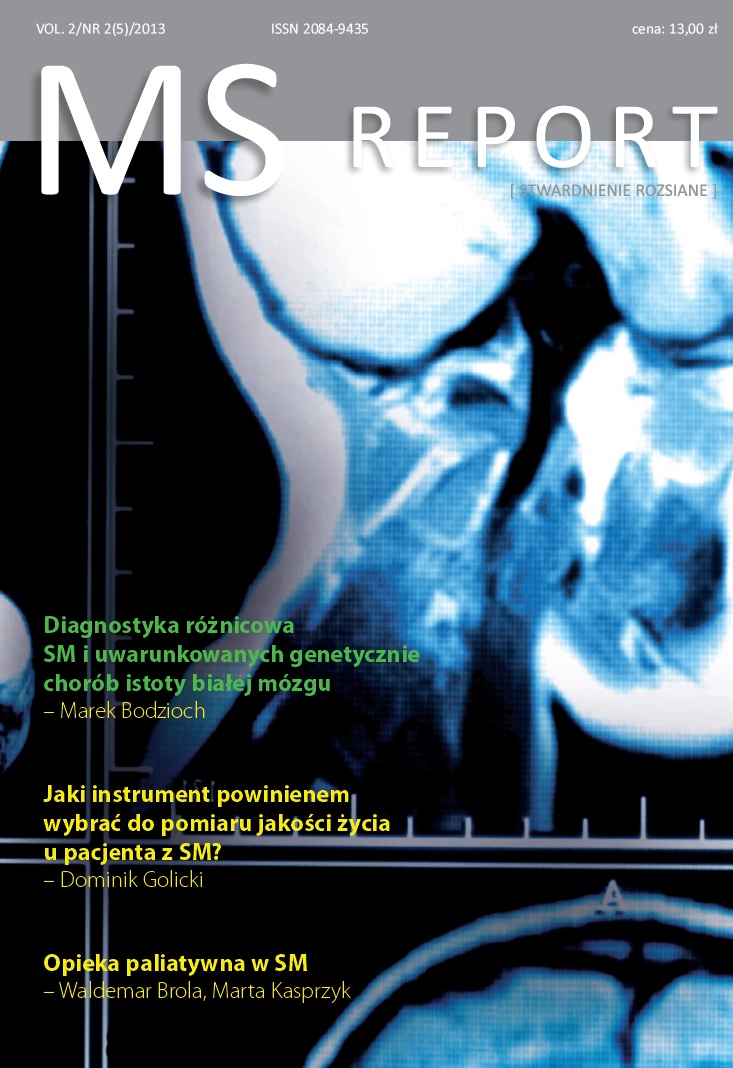Differential diagnosis of multiple sclerosis and genetic cerebral white matter disorders Review article
Main Article Content
Abstract
Genetic cerebral white matter disorders are an important albeit underestimated option in the differential diagnosis of multiple sclerosis. Apparently, they are considerably more prevalent than commonly believed but often remain unrecognized or misdiagnosed as multiple sclerosis. Correct diagnosis of a genetic disorder has a significant impact on prognosis, prophylactic and therapeutic management (including disease-modifying therapies in selected cases), genetic counseling as well as carrier status determination among the family members. Effective identification of patients with an increased risk of a genetic etiology may be improved by the implementation of the proposed four mainstays of the differential diagnosis: family history, magnetic resonance imaging, clinical course, and associated abnormalities. Features suggestive of a genetic disorder (and less likely associated with multiple sclerosis) recognized in at least one of these four mainstays provide justification for further detailed testing in order to identify the specific genetic defect.
Article Details
Copyright © by Medical Education. All rights reserved.
References
2. Bonkowsky J.L., Nelson C., Kingston J.L. et al.: The burden of inherited leukodystrophies in children. Neurology 2010; 75: 718-25.
3. Fluharty A.L.: Arylsulfatase A. Deficiency. W: GeneReviews™. Pagon R.A., Bird T.D., Dolan C.R., Stephens K., Adam M.P. (red.). University of Washington, Seattle 1993–2013.
4. Steinberg S.J., Moser A.B., Raymond G.V.: X-Linked Adrenoleukodystrophy. W: GeneReviews™. Pagon R.A., Bird T.D., Dolan C.R., Stephens K., Adam M.P. (red.). University of Washington, Seattle 1993–201.
5. Adib-Samii P., Brice G., Martin R.J., Markus H.S.: Clinical spectrum of CADASIL and the effect of cardiovascular risk factors on phenotype: study in 200 consecutively recruited individuals. Stroke 2010; 41: 630-4.
6. Potemkowski A.: Analiza epidemiologiczna stwardnienia rozsianego w województwie szczecińskim: ocena zachorowalności i chorobowości w latach 1993–1995. Neurol. Neurochir. Pol. 1999; 33: 34-44.
7. Ługowska A., Ponińska J., Krajewski P. et al.: Population carrier rates of pathogenic ARSA gene mutations: is metachromatic leukodystrophy underdiagnosed? PLoS One 2011; 6: e20218.
8. Sadovnick A.D., Dircks A., Ebers G.C.: Genetic counselling in multiple sclerosis: risks to sibs and children of affected individuals. Clin. Genet. 1999; 56: 118-22.
9. Mahmood A., Dubey P., Moser H.W., Moser A.: X-linked adrenoleukodystrophy: therapeutic approaches to distinct phenotypes. Pediatr. Transplant. 2005; 7(suppl): 55-62.
10. Prust M., Wang J., Morizono H. et al.: GFAP mutations, age at onset, and clinical subtypes in Alexander disease. Neurology 2011; 77: 1287-94.
11. Kanekar S., Gustas C.: Metabolic Disorders of the Brain: Part I. Semin. Ultrasound CT MRI 2011; 32: 590-614.
12. Kanekar S., Verbrugge J.: Metabolic Disorders of the Brain: Part II. Semin. Ultrasound CT MRI 2011; 32: 615-636.
13. van der Knaap M.S., Pronk J.C., Scheper G.C.: Vanishing white matter disease. Lancet Neurol. 2006; 5: 413-23.
14. Nandhagopal R., Krishnamoorthy S.G.: Neurological picture. Tigroid and leopard skin pattern of dysmyelination in metachromatic leucodystrophy. J. Neurol. Neurosurg. Psychiatry 2006; 77: 344.
15. Namekawa M., Takiyama Y., Honda J. et al.: Adult-onset Alexander disease with typical „tadpole” brainstem atrophy and unusual bilateral basal ganglia involvement: a case report and review of the literature. BMC Neurol. 2010; 10: 21.
16. Eichler F., Mahmood A., Loes D. et al.: Magnetic Resonance Imaging Detection of Lesion Progression in Adult Patients With X-linked Adrenoleukodystrophy. Arch. Neurol. 2007; 64: 659-664.
17. O’Sullivan M., Jarosz J.M., Martin R.J., Deasy N., Powell J.F., Markus H.S.: MRI hyperintensities of the temporal lobe and external capsule in patients with CADASIL. Neurology 2001; 56: 628-34.
18. Rolfs A., Bottcher T., Zschiesche M., Morris P., Winchester B., Bauer P., Walter U., Mix E., Lohr M., Harzer K., Strauss U., Pahnke J., Grossmann A., Benecke R.: Prevalence of Fabry disease in patients with cryptogenic stroke: a prospective study. Lancet 2005; 366: 1794-6.
19. Küker W., Weir A., Quaghebeur G., Palace J.: White matter changes in Leber’s hereditary optic neuropathy: MRI findings. Eur. J. Neurol. 2007; 14: 591-3.
20. Palace J.: Multiple sclerosis associated with Leber’s Hereditary Optic Neuropathy. J. Neurol. Sci. 2009; 286: 24-7.
21. Nikoskelainen E.K.: Clinical picture of LHON. Clin. Neurosci. 1994; 2: 115-20.
22. Jangouk P., Zackowski K.M., Naidu S., Raymond G.V.: Adrenoleukodystrophy in female heterozygotes: underrecognized and undertreated. Mol. Genet. Metab. 2012; 105: 180-5.
23. Razvi S.S., Bone I.: Single gene disorders causing ischaemic stroke. J. Neurol. 2006; 253: 685-700.
24. Yatsuga S., Povalko N., Nishioka J. et al.: MELAS: a nationwide prospective cohort study of 96 patients in Japan. Biochim. Biophys. Acta 2012; 1820: 619-24.
25. Ghezzi A., Deplano V., Faroni J. et al.: Multiple sclerosis in childhood: clinical features of 149 cases. Mult. Scler. 1997; 3: 43-6.
26. Mehta A.B.: Anderson-Fabry disease: developments in diagnosis and treatment. Int. J. Clin. Pharmacol. Ther. 2009; 1(suppl): S66-74.
27. Pisani A., Visciano B., Roux G.D. et al.: Enzyme replacement therapy in patients with Fabry disease: state of the art and review of the literature. Mol. Genet. Metab. 2012; 107: 267-75.
28. Garavelli L., Rosato S., Mele A. et al.: Massive hemobilia and papillomatosis of the gallbladder in metachromatic leukodystrophy: a life-threatening condition. Neuropediatrics 2009; 40: 284-6.
29. Ghezzi L., Scarpini E., Rango M. et al.: A 66-year-old patient with vanishing white matter disease due to the p.Ala87Val EIF2B3 mutation. Neurology 2012; 79: 2077-8.
30. Anderson P.J., Leuzzi V.: White matter pathology in phenylketonuria. Mol. Genet. Metab. 2010; 1(suppl): S3-9.
31. Apartis E., Blancher A., Meissner W.G. et al.: FXTAS: new insights and the need for revised diagnostic criteria. Neurology 2012; 79: 1898-907.
32. Taylor R.A., Simon E.M., Marks H.G., Scherer S.S.: The CNS phenotype of X-linked Charcot-Marie-Tooth disease: more than a peripheral problem. Neurology 2003; 61: 1475-8.

